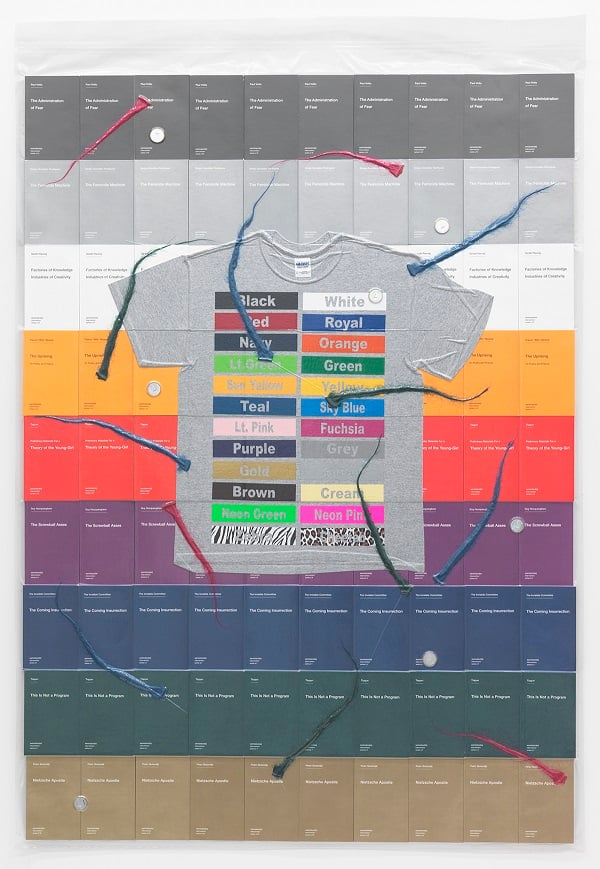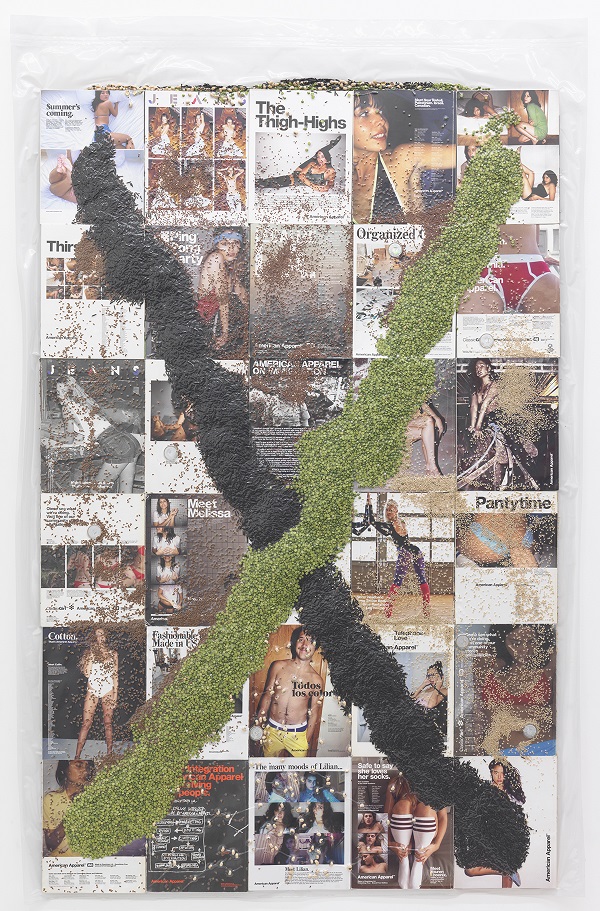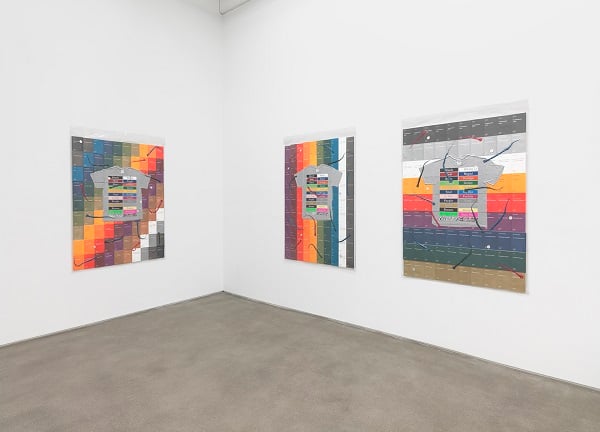Art & Exhibitions
Can Tumblr Sensation Brad Troemel Find Viral Success IRL?
Paddy Johnson reviews Brad Troemel's first solo show at Zach Feuer.

Paddy Johnson reviews Brad Troemel's first solo show at Zach Feuer.

Paddy Johnson


Brad Troemel, “FREEDOM LIGHTS OUR WORLD (FLOW)” (2014). Installation view.
Courtesy Zach Feuer Gallery, New York.
On my way out of Zach Feuer last week, I informed my friend that I would be writing about the gallery’s Brad Troemel show, FREEDOM LIGHTS OUR WORLD, (GLOW), because his work, as I explained, “is the kind of weird the Internet loves.” He’s been the subject of a feature story on Yahoo News for his work as the co-founder of the Jogging, a collaborative Tumblr known for posting manipulated photographs, memes, and hybrid products with no discernible function. The Jogging also made Time’s list of the top 30 Tumblrs to follow last year, and his Etsy project, which sells items like locked tacos and roses in “mildly customizable” meatball sandwiches, has been the subject of fascination at Gawker.
My friend, unaware of Troemel’s endeavors and following, just looked at me funny and asked: “What is there to say about this?”
He has a point. It’s hard to figure out exactly what’s being said, even after a day of tracking down the Internet references. I assumed they were essential to understanding the work, which was silly. What a locked taco or rose sandwich says on the Internet is different from how it will read in a gallery. Sometimes the translation works, and sometimes it doesn’t.
Troemel’s exhibition occupies a small room in the back of Zach Feuer’s space, with a handful of vacuum-sealed panels that contain food, printed text, and materials sourced from the Internet arranged in patterns and grids. There are clearly systems behind the arrangements, but they are opaque; it’s up to the viewer to identify their significance.

Brad Troemel, 90 Semiotext(e) books (10 The Administration of Fear, 10 The Femicide Machine, 10 Factories of Knowledge Industries of Creativity, 10 The Uprising: On Poetry and Finance,10 Theory of the Young Girl, 10 The Screwball Asses, 10 The Coming Insurrection, 10 This is Not a Program, 10 Factories of Knowledge Industries of Creativity), Fox Valley Mall T-shirt shop swatch fabric sample, 13 customized human hair dredlocks (4 green dredlocks, 5 blue dredlocks, 4 red dredlocks), 7 Limited edition Lealana 1 Litecoin pieces (2014).
Courtesy of Zach Feuer Gallery, New York.
On one wall hang three vacuum-packed grids of Semiotext(e) books (volumes of critical theory) arranged by color. They lay flat behind a T-shirt with a range of T-shirt color preference options printed on the front in place of one particular color. Shiny silver coins—physical representations of the digital currency Litecoin—and 12 “customized human hair dreadlocks” that look like sperm are laid on top of the books. On another wall we see three of the same grids, but this time Troemel uses copies of Vice magazine with American Apparel advertisements, along with Litecoins and a variety of grains sealed into the packs.
The vacuum pack, as I see it, is a visual nod to Seth Price’s essay “Dispersion,” which, when displayed in galleries, is printed and vacuum-packed. In the essay, Price asks whether it’s possible to identify conceptual art online when removed from the high-art context the gallery provides. That question probably made Price’s career; answering it has made Troemel’s.
The solutions Troemel has found are simple. Maintain gallery pricing and incorporate the bland captioning language of museums into posting work online. (For example, the caption “Beets By Dre, 2014, Beets, Chord, Paper,” under a picture of a student wearing beet headphones, is a typical caption on The Jogging.) Use the Etsy marketplace to create a spectacle of undesirability and then talk to the press occasionally about the projects’ weirdness.
Transposed into a gallery, some of this doesn’t work out so well. As a viewer, you end up looking for meaning in the decision to print color preference options on a T-shirt, rather than delighting in the absurdity of the act. At one point, I actually considered the idea that the grains splattered on top of the magazines to form three Xs (“XXX”) were intended to indicate a level of tangible physical realness in contrast to the ethereal Litecoins. While the Internet may have inspired a kind of work that benefits from a distracted viewership, some of it doesn’t hold up to the kind of sustained analysis one brings to a brick and mortar setting.

Brad Troemel, 30 Vice Magazines (2004-2014), Whole Foods Organic Black Wild Rice, Whole Foods Organic Flax Seed,Whole Foods Organic Green Split Peas, Whole Foods Organic Black Eyed Peas,Whole Foods Organic Sesame Seeds, Whole Foods Organic Red Quinoa, 7 Limited edition Lealana 1 Litecoin pieces, (2014).
Courtesy of Zach Feuer Gallery, New York.
Of all the gestures, Troemel’s use of the Litecoin—an alternative currency with all the potential black market applications of Bitcoin and a fraction of the users—probably works best in the gallery context. The kind of subcultural shadiness that’s associated with the crypto-currency seems to indirectly address the concerns of an unregulated art world, and the very structure of the currency provides a direct parallel to how value is constructed in the art world. Like Litecoin’s “block chain,” a built-in algorithm that creates a digital trail of every transaction ever executed, the art market uses provenance to construct value. The coins themselves may be just swag, but they’re now packaged as a known asset class, poised to take on a new value as art.
But this may be a generous assessment. The meaning of other references in the work seems arbitrary. As Troemel outlines in his essay “Athletic Aesthetics,” the focus of many online artists such as himself has more to do with “recognizing patterns amid flow” than it does with creating a carefully curated selection of work with a fixed message. Artists are “aesthetic athletes” (“aesthletes”) who focus on content production rather than craft.
Troemel’s essay and the ideas it expresses reflect the sensibilities of the Jogging, the name itself being a reference to constant workflow. The blog’s strategy of frantically posting weird shit even maps back onto Price’s “Dispersion” essay, which views conceptual art through the lens of Allan Kaprow, who maintained that art and life should not be separate. The end goal here, though, isn’t the advancement of art, but the furtherance of personal brands under the guise of art. Unsurprisingly, that endeavor does not translate well into a gallery setting, where audiences demand—and deserve—a more thoughtful message.
Brad Troemel’s “FREEDOM LIGHTS OUR WORLD (FLOW)” continues at Zach Feuer through March 29.

Brad Troemel, “FREEDOM LIGHTS OUR WORLD (FLOW)” (2014). Installation view.
Courtesy Zach Feuer Gallery, New York.